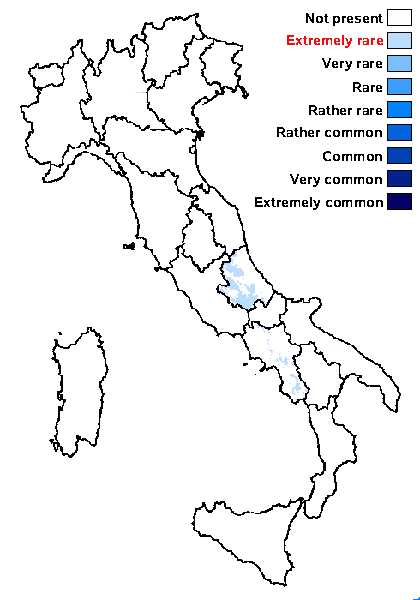Polyblastia nidulans (Stenh.) Arnold
Ber. naturhist. Ver. Brandenburg, 14: 64, 1861. Basionym: Verrucaria nidulans Stenh. - Öfvers. K. Svensk. Vetensk.-Akad. Förh.: 121, 1857.
Synonyms:
Distribution: C - Abr (Nimis & Tretiach 1999, Cucchi & al. 2009, Gheza & al. 2021). S - Camp (Garofalo & al. 2010).
Description: Thallus crustose, endosubstratic, pale grey to pale brown. Perithecia black, 0.2-0.3 mm across, completely immersed in the rock. Involucrellum absent; hamathecium of periphyses and periphysoids, interascal filaments absent; hymenial gel hemiamyloid, I+ red (I+ blue at very low concentrations of I), K/I+ blue. Asci 8-spored, clavate, K/I-, fissitunicate, the wall thickened above, with an ocular chamber, dehiscent by extrusion of an endotunica to form a delicate rostrum. Ascospores muriform, at first hyaline, then turning brown to brown-black, ellipsoid, 21-40(-50) x 15-24 µm. Photobiont chlorococcoid. Spot tests: K-, C-, KC-, P-, UV-. Chemistry: without lichen substances.Note: on compact limestone and dolomite in sheltered situations, with optimum above treeline, reaching the nival belt; probably occurring also in the Alps. The record from Campania requires confirmation. According to Savić & al. (2008), the species belongs to the Thelidium-clade, not to Polyblastia s.str.
Growth form: Crustose endolithic
Substrata: rocks
Photobiont: green algae other than Trentepohlia
Reproductive strategy: mainly sexual
Commonnes-rarity: (info)
Alpine belt: extremely rare
Subalpine belt: very rare
Oromediterranean belt: absent
Montane belt: extremely rare
Submediterranean belt: absent
Padanian area: absent
Humid submediterranean belt: absent
Humid mediterranean belt: absent
Dry mediterranean belt: absent

Predictive model
Herbarium samples
Growth form: Crustose endolithic
Substrata: rocks
Photobiont: green algae other than Trentepohlia
Reproductive strategy: mainly sexual
Commonnes-rarity: (info)
Alpine belt: extremely rare
Subalpine belt: very rare
Oromediterranean belt: absent
Montane belt: extremely rare
Submediterranean belt: absent
Padanian area: absent
Humid submediterranean belt: absent
Humid mediterranean belt: absent
Dry mediterranean belt: absent

Predictive model
| Herbarium samples |
 Index Fungorum
Index Fungorum
 GBIF
GBIF




